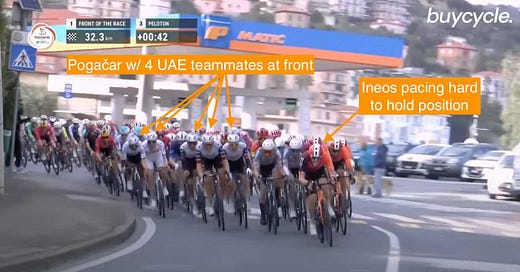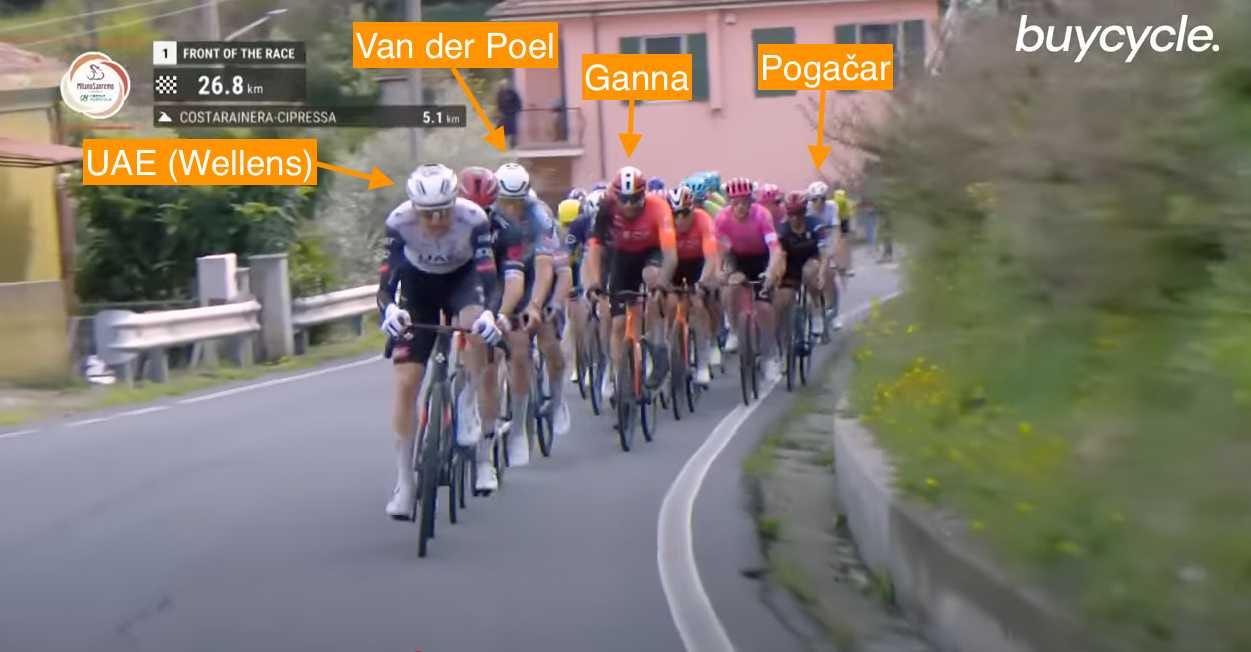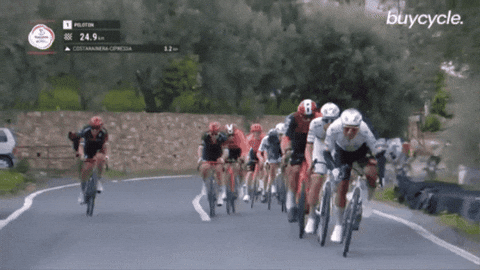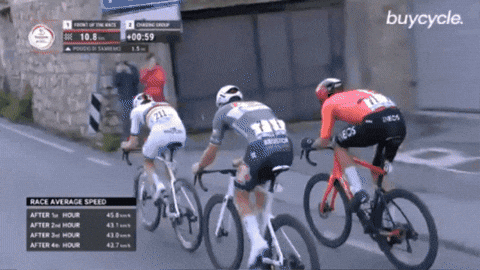Key Takeaways: Milan-Sanremo
Breaking down what the clash of the titans at the first Monument of the season taught us about the rest of the season & how it potentially changed the nature of the race forever
Mathieu van der Poel continued to build out his resume as one of the most potent one-day racers in the sport’s history when he shrugged off a searing attack from Tadej Pogačar on the Cipressa and beat both him and Filippo Ganna to win his second-career Milan-Sanremo title. After Van der Poel was able to follow the initial audacious attack from Pogačar that instantly pulverized the peloton, he successfully parried the World Champion’s following surges over the Poggio before almost effortlessly winning a three-rider sprint over Pogačar and Ganna, who had made contact with the group inside the final kilometer after a frantic chase. Pogačar’s early attack ignited a battle between three titans, creating an instant classic that will undoubtedly be regarded as one of the best editions in recent history.
Milan-Sanremo 2025 Top Ten
1) Mathieu van der Poel (Alpecin-Deceuninck) +0
2) Filippo Ganna (INEOS Grenadiers) +0
3) Tadej Pogačar (UAE Team Emirates-XRG) +0
4) Michael Matthews (Jayco AlUla) +43
5) Kaden Groves (Alpecin-Deceuninck) +43
6) Magnus Cort (Uno-X Mobility) +43
7) Mads Pedersen (Lidl-Trek) +43
8) Olav Kooij (Visma-Lease a Bike) +43
9) Matteo Trentin (Tudor Pro Cycling) +43
10) Fred Wright (Bahrain-Victorious) +43
To expand on my initial Milan-Sanremo thoughts from Saturday after the race, I’ve broken down the key takeaways from the early-season Italian Monument below:
Race Notebook
32.3km-to-go: As the peloton gradually awakens from its malaise after 260 kilometers of racing through the cold rain of northern Italy, Tadej Pogačar and his remaining UAE teammates move to the front as Ineos drive an extremely hard pace into the base of the Cipressa, the penultimate climb of the day.
26.8km: However, by the time they hit the lower slopes of the climb, Pogačar’s teammates have largely disappeared, with a lone Tim Wellens pacing on the front, while Pogačar is buried deep in the field, meaning he has a lot of work to put in before he can even be in position to attack. Meanwhile, Ineos’ work has paid off, with Ganna perfectly positioned a few wheels back, and Mathieu Van der Poel is sitting in third wheel, ready to respond to any potential attacks.
24.9km: After Wellens’ pull is done, Pogačar carves through the field just as his last remaining teammate Jhonatan Narváez hits the front in a full-out sprint. Behind, riders are already falling off the wheel, with Ganna and Van der Poel, due to their perfect positioning and extremely high power outputs, able to hold the wheel.
24.7km: When Narváez’s sprint is over, Pogačar makes the right decision to instantly attack, which doesn’t allow the already-pinned competition to catch their breath.
24.6km: While some riders are able to sustain Pogačar’s initial assault, his continued high pace, which is likely seeing him average between 600-700 watts, shreds the peloton, with only Ganna, Van der Poel and Romain Grégoire able to hold the wheel.
24.5km: As Pogačar continues his pressure, Ganna loses the wheel. Interestingly, Van der Poel stays glued to his wheel, likely trusting that leeching of one of the strongest riders in the sport will save him more energy, compared to jumping around and trying to close the gap himself.
23.2km: When Ganna gets within roughly a meter of Pogačar, Van der Poel deftly jumps around and onto Pogačar’s wheel. Ganna is briefly dropped (while Grégoire is spat with great speed out of the back) but catches on before the descent with an impressively high sustained pace. Interestingly, Van der Poel begins taking pulls at the front, which suggests he believes that if he hasn’t been dropped yet, the remaining course won’t be hard enough to dislodge him.
10.8km-9.1km: Even with the peloton languishing a minute back, Pogačar is taking hard turns at the front as they head into the Poggio. As soon as they hit the climb, he attacks. Van der Poel is able to respond while Ganna is forced to ride his own pace.
7.7km: With Van der Poel still hugging his rear wheel, Pogačar is forced to attack from the front when he hits the steepest portion of the Poggio. This unideal attack from the front can’t shake Van der Poel, as Ganna impressively rides alone just a few meters back.
6.1km: When the pace comes off as they hit the flatter portion of the climb near the summit (which suits Van der Poel), Van der Poel impressively, and smartly, attacks, which means Pogačar has to put in a huge effort to just get even with Van der Poel before the summit, instead of using the last remaining uphill kilometers to distance him.
1.4km-800m: Coming off the descent and into the town of Sanremo, Ganna is still chasing a few meters back, while Pogačar makes the odd decision to pull through incredibly hard, instead of sitting in to save energy for the sprint against the faster Ganna, or allowing Ganna to catch on and using the added variable to muddy the waters.
250m: When Ganna catches the leading duo inside the final kilometer, Pogačar sits up and allows a gap to form between himself and Van der Poel, presumably so that he can build up speed and gap Van der Poel as he passes him in the sprint. However, Van der Poel recognizes this immediately and starts his sprint while Pogačar is still out of his slipstream.
Finish: This early jump from Van der Poel allows him to hold off Ganna and Pogačar with his strong sprint through the final few hundred meters and win his second Sanremo in three years.
Five Key Takeaways
The first three takeaways are a slightly edited version of my initial post-race thoughts sent to premium subscribers directly after the race on Saturday
1) Mathieu van der Poel Is on Career-Best Form: After displaying perfect form, poise, and tactical awareness through the finale, the Dutch superstar won his second edition of Sanremo in the last three years (with his Alpecin team winning the last three), and got his seventh career Monument victory to pull even with Tadej Pogačar as the active rider with the most wins at the biggest one-day races (and seventh most of all-time). However, unlike his first Sanremo win back in 2023, this one was less about finesse and skill and more about raw power and near-absurd fitness.
When Pogačar let it rip on the final two climbs, Van der Poel was the only rider with the legs to answer the call and actually took the fight to Pogačar at the critical section at the top of the Poggio, which put Pogačar on the defensive and ensured a sprint finish, which greatly favored the larger and more powerful Van der Poel.
At just 65 kilograms, Pogačar, adjusting for the tailwind benefit, must have generated around 500 watts on the nine-minute ascent of the Cipressa, which means at roughly ten kilograms heavier, Van der Poel would have had to average roughly 550 watts for the same ascent.
Highlighting just how much of a disadvantage Pogačar was at compared to the heavier Van der Poel on this course, Pogačar actually would have had to generate more watts per kilogram over the Cipressa than Van der Poel, even at a lower raw power output, to climb at the same speed. This highlights just how much a relatively short and mild gradient climb favors bigger riders with the ability to generate higher power outputs.
The fitness required to put out this amount of power, and then recover to do it again on the Poggio, shows us the high level he is at right now.
The only thing that could really stop Van der Poel from winning is going over the top of the Poggio with a larger group and either being outsprinted by a rider like Jonathan Milan or Michael Matthews or caught out by a late attack by Pogačar.
Paradoxically, Pogačar’s attack and the resulting selection played directly into Van der Poel’s hands, increasing his chances of winning.
2) Van der Poel Maximized His Best Possible Outcome at Every Turn: However, while the win was a testament to Van der Poel’s current (potentially career-best) fitness, it didn’t come without its fair share of tactical acumen. For example, while UAE’s (depleted) team went to the front to wind things up on the Cipressa, Van der Poel smartly slotted into second wheel, directly behind Tim Wellens, so that he was placed in between Wellens and Jhonatan Narváez/Tadej Pogačar. This allowed him to control the pace after Wellens pulled off, and left him with almost no ground to cover when Pogačar launched his attack off Narváez’s wheel.
His decision to attack Pogačar at the top of the Poggio flipped the script, neutralizing Pogačar at one of the last remaining places in the race where he could have put Van der Poel under pressure. This move resulted in Pogačar making a major effort to pull even with Van der Poel at a key launch point of the finale instead of putting distance between himself and Van der Poel.
After staying with Pogačar on the Cipressa, which is even more impressive when we consider the stiff tailwind that made the climbing pace faster and favored Pogačar, Van der Poel surprised some when he decided to pull through with Pogačar on the flat stretch to the Poggio.
In retrospect, his decision is valid, but even at the moment, it was the right decision since, after marking Pogačar up the Cipressa, he had a great chance of staying with him on the much easier Poggio.
It may have looked crazy to some that he was so willing to work with Pogačar, but internally, he must have felt confident in his ability to stay with Pogačar on the Poggio and outsprinting both him and Ganna at the line, which presented a far better probability of a win than refusing to work, being caught and sprinting from a larger group against faster riders.
3) Tadej Pogačar Fails Once Again Despite Re-Writing the Rules of Sanremo Engagement: After failing to win the race with a nuclear-fast ascent of the Poggio in 2024, Pogačar clearly decided he needed to rip up the Sanremo script and opt for the highly unorthodox tactic of attacking on the Cipressa in the hope that he could get away solo, or with a reduced group, before attempting to drop them on the final climb of the Poggio. This move, even though it was ultimately unsuccessful and Sanremo remains the race that gives Pogačar the most trouble, has shown that a strong group, or even a single rider, can indeed ride clear before the final few kilometers and has likely re-defined how this event will be raced in the future.
His Cipressa attack, which blew up the peloton, leaving only Van der Poel and Ganna—the best-placed and strongest riders—on his wheel, was remarkable for its unprecedented nature and success despite being poorly set up by his team.
Despite everyone knowing it was coming, Pogačar dropped nearly the entire peloton—including riders like Tom Pidcock—on a relatively mild climb where almost nobody has ridden clear in modern history. What made it even more impressive was that he did so with minimal support from his UAE team, who once again botched their positioning at the base of the Cipressa and left Pogačar with only two teammates to set up his attack.
Considering this is the second consecutive year that Pogačar’s UAE teammates have struggled with positioning to set up an organized leadout on the Cipressa, it would be very easy to pin the blame on his support squad.
But, this is somewhat overly simplistic and might be overlooking the fact that the extremely long race might add enough fatigue to the legs of any team that it makes it nearly impossible to neatly organize with nearly 270 kilometers and 5.5 hours of racing in their legs.
After all, setting up an uphill leadout 1-2 hours into a Grand Tour stage is far different than 5+ hours into an extremely high-octane one-day race.
Instead of blaming his team, a key area where Pogačar could have improved his finishing position was his overeagerness to pull through with Van der Poel after being attacked at the top of the Poggio.
After reeling in his main rival at the top of the final climb, with Ganna chasing a few seconds behind, Pogačar would have been better served by slotting into Van der Poel’s draft and allowing Ganna to catch back on.
This would have added another variable, which Van der Poel, the stronger sprinter, would have been forced to control. This could have given Pogačar a free ride to the sprint or an opportunity to attack while Van der Poel and Ganna marked each other
Instead, he continued to take a few incredibly strong pulls to keep Ganna distanced through the final few kilometers. This only allowed Van der Poel to get a few precious moments of rest and kept a key sprint rival out of the equation.
4) The Layering of the Battle for the Sport’s Dominant One-Day Rider: In the wake of yet another duel between the sport’s two top one-day riders, the inevitable questions about what this win does for Van der Poel’s ranking and legacy as a one-day contender.
While Van der Poel’s win was impressive and potentially foreshadows more to come this spring, Pogačar still has his number in recent years, winning four out of the last six meetings in major one-day races.
However, if we pull back, we can see the two riders have remarkably similar results in one-day Monuments, sharing a 63% podium rate and sporting astonishingly good win rates of 37% and 44%.
Van der Poel (30) Career Monument Stats:
19 Monument Starts
18 Top Tens
12 Podiums
63% podium rate
7 Wins
37% win rate
Pogačar (26) Career Monument Stats
16 Monument Starts
13 Top Tens
10 Podiums
63% podiums rate
7 Wins
44% win rate
Pogačar's ability to rack up the same number of wins at a younger age( 26 vs 30) tips the balance in his favor, but their duels in the coming weeks could shift these stats considerably.
These one-day stats from Van der Poel and Pogačar are nearly unprecedented and certainly not something I’d ever see in modern racing.
In fact, if we look at how the greatest rider of all time, Eddy Merckx, fared at the same point in his Monument career, while his raw numbers are higher due to a surprisingly high rate of participation, his podium and win rates are roughly in line with Pogačar and Van der Poel.
Merckx’s (27) Monument Stats in His First Seven Years
33 Monument Starts
29 Top Tens
20 Podiums
61% podium rate
13 Wins
39.5% win rate
5) The Rest of the Contenders May Need to Join Forces With the Major Stars to Have Any Hope of Winning: With this victory continuing the trend of just four riders winning all major one-day races over the last 2.5 years (Van der Poel, Pogačar, Remco Evenepoel, and Jasper Philipsen), the performances of Van der Poel and Pogačar don’t bode well for riders outside this Galáctico-tier.
Consider Filippo Ganna, who put in what is perhaps the best ride of his career and still couldn’t convert it into a Monument victory.
Additionally, Tom Pidcock, who came closest to matching Pogačar at Strade Bianche, was caught out of position on the lead-in to the Cipressa, likely due to not having the same level of team support, and dropped on the climb.
The sight of Jhonatan Narváez, one of the only riders to beat Pogačar in 2024, working for him on the Cipressa and Jasper Philipsen being handed the 2024 Milan-Sanremo title on a platter by Van der Poel potentially shone a dim light on the future of these sub-supersonic contenders.
If they want to defeat the sport’s new royalty, the best way to do this might be to join their teams instead of attempting to storm the castle from the outside.
I also wonder how Wout van Aert, who has only won one Monument in his career, felt watching from the sidelines as one of his biggest Classics rivals won his seventh career Monument and the other racked up his 13th consecutive Monument top-five result (in races he has finished).
His road toward winning either the Tour of Flanders or Paris-Roubaix, one of which he desperately needs to win this season if he wants to continue to be considered a top one-day contender, looks increasingly difficult after this peerless display from his top competition.

















Great analysis, Spencer. Van der Poel's combination of power and tactics showed how awesome this sport is. Thank you.
Striking how little team support MVDP needed for the finale. His form and tactics on the day were outstanding. Looking forward to the Van der Poel v Pogacar battles to come over the next couple of weeks.